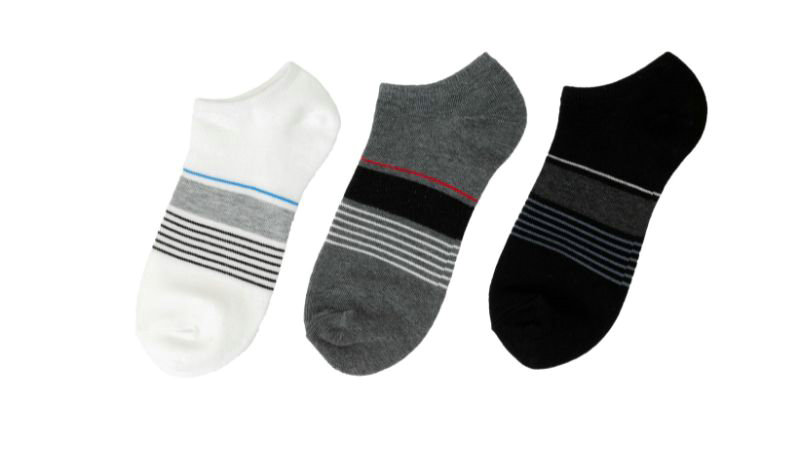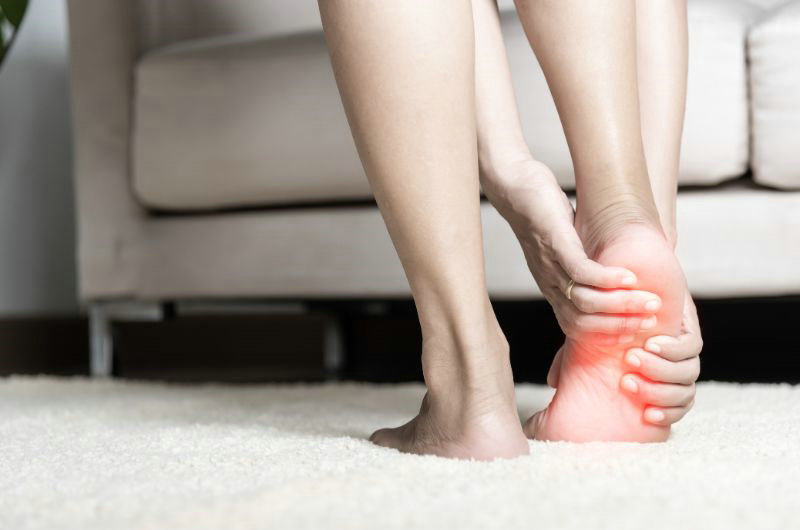
For many runners, socks are an essential piece of gear that keep feet comfortable mile after mile. However, some choose to forgo socks during runs in the name of lighter, freer foot movement.
Barefoot running has grown in popularity as both a training style and a performance technique. But is running sockless safe and advisable for most runners? This article takes a look at the potential pros and cons of going barefoot in your running shoes.
Running Socks or No Socks
So, you might be wondering whether it’s a good idea to wear running shoes without socks. You can run without socks, but there are a few factors to consider before deciding whether or not it’s the right choice for you.
First, let’s talk about the benefits of wearing socks while running. One key advantage of running socks is that they provide extra protection for your feet. High-quality running or compression socks reduce friction between your feet and shoes, offering a layer of defense against blisters and chafing. Additionally, wicking socks made of moisture-wicking fabrics help keep your feet dry and comfortable, reducing the likelihood of developing dampness-related issues.
On the other hand, running without socks might make you feel faster. Some track athletes and sprinters choose to forgo socks, believing that less material can lead to improved performance. While there isn’t clear research supporting this idea, it’s worth considering if you’re curious about potentially increasing your speed.
Another benefit of going sockless is that it can help keep your feet cooler during hot summer runs. Without the extra layer of fabric, there’s more space for air to circulate around your feet, leading to a cooler experience.
However, there are some drawbacks to running without socks. For one, your feet will be more likely to sweat, creating an uncomfortable, damp environment inside your running shoes. This can increase friction and the chances of developing blisters or experiencing chafing. Additionally, debris and sand can be particularly annoying, even painful, for sockless runners.
Risks and Challenges of Running without Socks
Although running without socks may seem like a simple and liberating option, there are several risks and challenges to consider.
Reasons why you might to wear socks when running:
Blister Formation
Socks can help prevent blisters. When you run without socks, your bare feet are in direct contact with the inner fabric of your shoes. As you move, friction increases between your skin and shoes. Over time, this causes blisters to form on pressure points like your heels and toes. Blisters can be quite painful, especially on long runs. Large blisters may even force you to cut a run short or take time off from running to heal.
Foot Irritation
The repeated impact and friction of running barefoot inside shoes leads to irritation of the skin on your feet. Without a moisture-wicking sock barrier, your feet are exposed to chafing from shoe fabric. On hot days, sweat builds up and adds to discomfort. Over multiple runs, this irritation can turn into hot spots, redness, or even small cuts or cracks in the skin.
Bacterial Infections
When you run without socks, your bare feet pick up dirt, debris, and bacteria from the ground and inside your shoes. Even a minor cut or scrape provides an entry point for infection. Without a clean sock separating your skin from the inside of the shoe, you’re more at risk for developing bacterial or fungal infections like athlete’s foot. These can cause itching and pain and may require medical treatment.
Heat Stress
Running in hot weather without socks can cause your feet to overheat. Socks help to wick away moisture and sweat from your skin, regulating its temperature. Heat Stress Socks play an important role in regulating foot temperature during runs, especially in hot and humid conditions. Without socks to wick away moisture, sweat generated by your feet has nowhere to go inside the shoe. This trapped heat and moisture can lead to overheating of the feet. On long runs, heat stress brings risks like swelling, rashes, or even heat exhaustion.
Washing and Hygiene Issues
When you run without socks, your bare feet sweat directly into your shoes. Without a moisture-wicking barrier, foot sweat is absorbed by the shoe fabric. This leads to the buildup of odor-causing bacteria. Over multiple runs, your shoes can develop a strong unpleasant smell. More frequent washing is needed to remove the sweat and keep your shoes from stinking. However, machine washing can degrade shoe materials more quickly. The extra cleaning requires time and effort which reduces the usable lifespan of your shoes.
Smelly Feet
While foot sweat itself is odorless, it is the bacteria breaking down the sweat that produces malodorous compounds. As more bacteria accumulates with each sockless run, the smell worsens. Within a day or two, shoes may develop a strong, unpleasant odor. This proliferation of bacteria poses health risks as well. Increased bacteria on the skin can potentially lead to fungal infections like athlete’s foot. Minor cuts or cracks in the skin provide entry points for pathogens.
Can No-socks Running Harm Your Shoes?
The increased friction between bare feet and shoe fabric causes more wear and tear with every step. Sweat acts as a lubricant that breaks down cushioning foam and damages stitching as feet slide back and forth inside shoes. Without socks to absorb impact, your feet also hammer the shoe from within. This repeated pounding and moisture breaks down shoe construction overruns. Pebbles or debris stuck to bare feet can abrade and puncture uppers. The resultant premature wear shortens the time before shoes need replacing. Frequent reshoeing is an added cost of running sockless.
How to Chose a Proper Socks Before Running

When selecting the perfect running socks for your needs, it’s essential to consider factors such as breathability, compression, and the type of terrain you’ll be running on. Choose ones that can effectively wick moisture away, regulate temperature, and minimize friction on your feet. Here are a few tips discussing the best types of socks to wear with your running shoes.
Breathability
The breathability of your running socks is crucial, as it determines your comfort level during a run. Depending on the weather conditions and the intensity of your runs, you may prefer different thicknesses for optimal perspiration wicking. The material your socks are made from plays a significant role in keeping your feet comfortable and dry. Avoid 100% cotton socks, as they retain moisture. Instead, opt for synthetic materials or natural fibers like bamboo, merino wool, or a blend of these with some synthetic fibers offering moisture-wicking capabilities and durability. Merino wool is particularly great for thermoregulation; it keeps your feet warm when it’s cold and cool when it’s hot outside.
Compression
Compression socks can help reduce muscle fatigue by facilitating blood backflow and minimizing muscle soreness. Some compression socks also feature reinforced zones for added stability and support. They also allow you to adapt quickly to various weather conditions and may help prevent injuries. It’s worth considering adding a pair of compression socks to your running gear collection for those longer, more challenging runs.
Fitness
A properly fitting sock ensures your feet will stay comfortable during your run. Socks that are too tight may create added heat and discomfort, while socks that are too loose can lead to blisters or sore feet due to rubbing. A well-fitting sock should provide ample coverage for your entire foot and ankle without feeling restrictive.
Type of Run
The type of terrain you usually run on plays a significant role in choosing the right running socks. For flat terrain, such as pavements, park connectors, city roads, and stadium tracks, prioritize comfort. Look for socks that emphasize softness, lightness, and breathability.
On the other hand, if you venture into uneven terrain, such as rocky, slippery, or muddy trails with uphill and downhill obstacles, opt for running socks that provide better ankle support and shock protection on your calves. These socks can help prevent sprains and ensure a more comfortable run on uneven surfaces.
What To Do If You Want To Go Without Socks

To make your experience more enjoyable and comfortable, it’s essential to prepare well and manage your footwear properly.
First, choose running shoes that are specifically designed for barefoot running. These shoes are constructed to provide a better fit and ensure maximum comfort during your run. In case you don’t have access to barefoot running shoes, ensure that your regular footwear is at least well-cushioned and has ample room for your feet to breathe.
Prevent foot odors, blisters, and chafing by applying talcum powder or anti-chafing products before slipping your feet into the shoes. This not only helps to absorb excess moisture but also creates a barrier between your feet and the shoes, reducing friction.
Lastly, be prepared to deal with setbacks as you begin your shoeless journey. It might take a while for your feet to adapt to running without socks, so give yourself some time and gradually ease into this change.
Running Without Socks
Start slow when transitioning to sockless runs. Build up mileage gradually to allow your feet to adjust and condition over time. Rush into longer distances without socks and you risk injury.
Inspect your feet before every run. Look for any cuts, blisters or hot spots that could cause issues without socks. Address any problems to avoid aggravating injuries.
Wash and thoroughly dry your feet daily, especially between the toes. Bacteria thrive in moist, warm areas and can cause infections without proper hygiene. Consider an anti-fungal spray as added protection.
Choose shoes carefully. Look for those with breathable, smooth interiors that won’t cause friction or irritation. Well-cushioned models absorb impact to protect bare soles. Consider adding insole pads for extra comfort.
Apply a lubricant like petroleum jelly or body glide to your feet before running. This creates a barrier between skin and shoe fabric to prevent chafing. Reapply during long runs as needed.
Maintain your shoes diligently by cleaning and airing them out regularly. Since socks wouldn’t be there to absorb sweat, your shoes may stink more when worn without them. Hence, good hygiene practice is crucial to keep odors at bay.
Consider wearing gloves, socks or sleeves just over your ankles. This protects vulnerable areas from rubbing while allowing most of the foot to breathe.
Carry bandages, blister pads, and antiseptic in case of any cuts or blisters during runs. Address issues promptly to prevent worsening.
Wash shoes after running and allow them to air dry fully. This removes sweat and odor-causing bacteria buildup from lack of socks.
Listen to your body. Stop any run if you feel hot spots, irritation or pain developing. It’s not worth aggravating an issue by pushing through discomfort without socks.
Sinokit, Why Us?
Experience the pinnacle of knitwear excellence with Sinoknit – Asia’s premier sock manufacturer.
For over 20 years, we have been crafting exquisite socks that fuse high fashion with functionality.
Our state-of-the-art facilities in China house the most advanced knitting technologies to create intricate designs and ensure consistent quality. Our talented designers stay ahead of trends to develop collections that captivate and inspire.
But what truly sets Sinoknit apart is our commitment to sustainability.
We utilize eco-friendly materials, renewable energy, and ethical practices to reduce our environmental impact. This enables us to produce premium socks that don’t cost the earth.
Our socks factory is equipped with over 300 computerized sock knitting machines imported from Italy and Korea. This allows us to produce up to 20 million pairs of socks per year. With an extensive range of over 100 sock varieties, we offer 96-needle, 108-needle, 120-needle, 132-needle, 144-needle, 168-needle, and 200-needle slim socks, terry socks, cotton-yarn socks, and woolen pants.
Our comprehensive services empower clients to bring their visions to life. From idea inception and sample development to bulk production and delivery, we handle it all. Our flexible MOQs, extensive capacity, and quick turnarounds make us the ideal partner for labels of any size.
Experience the Sinoknit difference. Our refined craftsmanship, creative flair, and responsible production create socks that are as beautiful on the inside as it is on the outside.
Contact us today to start your journey towards socks excellence.
Frequently Asked Questions
Can running without socks cause blisters?
Yes, running without socks may cause blisters. While it is possible to wear running shoes without socks, doing so may lead to increased friction between your feet and the shoes, resulting in chafing and blisters. Wearing socks provides an added layer of protection that reduces friction and helps keep your feet comfortable during workouts.
Are there risks of not wearing socks with workout shoes?
There are risks associated with not wearing socks with workout shoes. When you run or exercise without socks, your feet are more prone to sweat, which can create an uncomfortable and moist environment inside the shoes. This can lead to several issues, including unpleasant odor, bacteria growth, and potential infections. Additionally, as mentioned earlier, wearing shoes without socks may cause blisters and chafing due to the increased friction between your feet and shoes. To ensure your feet remain comfortable and healthy, it’s generally advisable to wear socks with your workout shoes.
If I wanna running without wearing socks, how should I choose the proper shoes?
Consider your pronation and pay attention to shoe flexibility. Choosing shoes with mesh which are designed to be worn when running bare foot is also a good choice. More flexible shoes allow for a more natural foot motion while stiffer shoes provide more stability control.
Check the shoe drop height. This refers to the difference in heel versus toe cushioning. A 4-10mm drop is standard, but some runners prefer lower or higher drop based on their form. Higher drop shoes encourage heel-striking while lower drop shoes are better for midfoot or forefoot striking.










